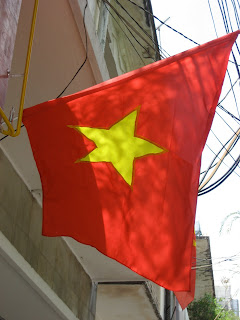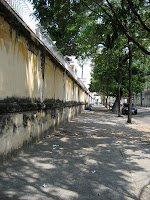Another week, another holiday.
Today marks 35 years since Southern Vietnam was liberated from well, itself in a way, and the Americans more importantly. On April the 30th in 1975, Northern Vietnamese Army tanks crashed through the gates of what is now known as the Reunification Palace in Saigon, and the American War was over. North and South could be reunited and Communism was here to stay.
To prepare for the celebrations, government authorities began closing off roads and constructing seating stands almost two weeks ago. On Tuesday morning this week, they shut down central Saigon at peak hour in order to rehearse the parade. Everyone was late for work and no one, foreigners and Vietnamese alike, seemed to have any prior knowledge that this would happen. Obviously this parade was going to be a big one. We were keen to go and watch, looking forward to being swept up in some nationalistic pride and atmosphere.
However, this photo is as close as we came to seeing the parade this morning. It turned out that the event was invitation only. These are the buses that would take the participants and invited spectators home. Many streets, including ours, where this photo was taken, were shut down and the riff raff were kept out.
We had to settle for the television broadcast. Unsurprisingly, there was a lot of military marching to begin with. I just kept thinking how hot these men must be in their dark green woollen uniforms. There was a large group of seated VIPs and officials, including quite a lot of older women in velvet ao dai, who I also felt for in the staggering pre-rainy season heat. As the soldiers passed the VIPs, the camera kept cutting to a shot of two old generals. Sometimes these two would salute or wave a small flag, however they always remained stone faced. After a while the military gave way to more colourful floats and groups of people representing various ethnicities and organisations. There was even a kind of interpretive re-enactment of the events of April 30, including older women rushing around, being reunited with their soldier sons and holding long embraces. Again they cut to the two old fellows, still no emotion.
Today, everything is red; flags, signs and banners with many stirring words and sentiments. As Uncle Ho once said, ‘Nothing is more valuable than independence and freedom.’ And these words span Le Duan boulevard (where the parade took place) today, on a rainbow like, yet red, inflatable banner.
Vietnam fought hard for independence over hundreds of years, first from the Chinese, then the French, the Japanese, the Americans. They are rightly proud of their independence. And freedom, well who would want to get into a philosophical debate about what that word means anyway? Certainly not me, as a foreigner living in a country, that although racing towards a free market is most definitely still Communist in so many other ways.












